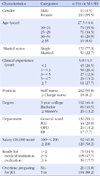Abstract
Purpose
The purpose of this study was to ascertain current status of nurses' perception, nursing performance, job stress, and burnout in relation to the Joint Commission International (JCI) hospital accreditation and to verify the relationships among these variables.
Methods
This cross-sectional study was performed using questionnaires. Data were collected from 220 nurses who worked at one hospital from April 5 to May 4, 2013.
Results
The scores for perception, nursing performance, job stress and burnout in relation to the JCI hospital accreditation were(on a five-point Likert scale) 3.23, 4.01, 3.56 and 3.40 respectively. A positive correlation was observed between perception and nursing performance. Burnout was negatively correlated with perception and nursing performance, and positively correlated with job stress.
Conclusion
These results indicate that developing positive perception and reduced burnout in relation to the JCI hospital accreditation can produce good nursing performance. These findings can be utilized to develop strategies for reducing job stress and burnout in relation to the JCI hospital accreditation.
Figures and Tables
References
1. Aiken LH, Sloane DM, Bruyneel L, Van den Heede K, Sermeus W. Nurses' reports of working conditions and hospital quality of care in 12 countries in Europe. Int J Nurs Stud. 2013; 50(2):143–153. http://dx.doi.org/10.1016/j.ijnurstu.2012.11.009. Epub 2012 Dec 17.
2. Bae JI. A study on hospital staff's perception of and attitudes toward the medical institute accreditation system: Focused on those working for the public hospitals. Seoul, Korea: Yonsei University;2008. Unpublished master's thesis.
3. Byun DS, Yom YH. Factors affecting the burnout of clinical nurses: Focused on emotional labor. J Korean Acad Nurs Adm. 2009; 15:444–454.
4. Cho HJ. Hospital employee's recognition and attitudes for healthcare accreditation. Busan, Korea: Catholic University;2012. Unpublished master's thesis.
5. Choi KJ. Factors that affect burnout of nurses. Seoul, Korea: Kyunghee University;2007. Unpublished master's thesis.
6. Choi YS. Effect of nurses' awareness on medical institution evaluation on nursing performance. Seoul, Korea: The Catholic University of Korea;2011. Unpublished master's thesis.
7. Cohen J. Statistical power analysis for the behavioral science. 2nd ed. New Jersey: Lawrence Erlbaum Associates;1988.
8. Demerouti E, Bakker AB, Nachreiner F, Schaufeli WB. The job demands-resources model of burnout. J Appl Psychol. 2001; 86:499–512. http://dx.doi.org/10.1037/0021-9010.86.3.499.
9. El-Jardali F, Jamal D, Dimass H, Ammar W, Tchaghchaghian V. The impact of hospital accreditation on quality of care: Perception of Lebanese nurses. Int J Qual Health Care. 2008; 20:363–371. http://dx.doi.org/10.1093/intqhc/mzn023.
10. Joint Commission International. JCI accreditation. 2013. Retrieved June 4, 2013. from http://ko.jointcommissioninternational.org/enko/.
11. Kim EK, Kang MN, Kim Y, Park JH, Park JH. Option and strategies on the national hospital evaluation program. J Korean Acad Nurs Adm. 2007; 13:40–52.
12. Kim HK, Ji HS, Ryu EK, Lee HJ, Yun SE, Jeon MK, et al. Factors influencing on burnout of the nurses in hospitals. Clin Nurs Res. 2005; 10(2):7–18.
13. Kim SM. A study on effects of the joint commission international (JCI) review on the awareness and attitude of hospital employees. Seoul, Korea: The Catholic University of Korea;2012. Unpublished master's thesis.
14. Maslach C, Schaufeli W. Historical and conceptual development of burnout. Washington, DC: Taylor & Frances;1993.
15. Mead N, Bower P, Roland M. The general practice assessment questionnaire (GPAQ) - Development and psychometric characteristics. BMC Fam Pract. 2008; 9:13. http://dx.doi.org/10.1186/1471-2296-9-13.
16. Park HS, Kim KN. Factors affecting burnout in ICU nurses. J Korean Acad Fundam Nurs. 2010; 17:409–418.
17. Park SA. An exploratory study on the relationship between leadership style and performance in Korean nursing units. Seoul, Korea: Seoul National University;1988. Unpublished doctoral dissertation.
18. Park SP. The effect of customer satisfaction policy on work stress and psychosocial distress in hospital employees. Seoul, Korea: Yonsei University;2005. Unpublished master's thesis.
19. Smith EL, Cronewett L, Sherwood S. Current assessment of quality and safety education in nursing. Nurs Outlook. 2007; 55(3):132–137. http://dx.doi.org/10.1016/j.outlook.2007.02.005.
20. Yi M, Oh JH, Hwang HM, Kwon EJ, Lee JH, Park EY. Hospital workers' experience with hospital evaluation program: A focus group study. J Korean Acad Nurs. 2011; 41:568–579. http://dx.doi.org/10.4040/jkan.2011.41.4.568.
21. Yoo MS, Chung MS. The relationships among the perception of quality assurance and national hospital evaluation program and nursing performance of hospital nurses. J Korean Acad Nurs Adm. 2008; 14:260–267.
22. You LM, Aiken LH, Sloane DM, Liu K, He GP, Hud Y, et al. Hospital nursing, care quality, and patient satisfaction: Cross-sectional surveys of nurses and patients in hospitals in China and Europe. Int J Nurs Stud. 2013; 50(2):154–161. http://dx.doi.org/10.1016/j.ijnurstu.2012.05.003.




 PDF
PDF ePub
ePub Citation
Citation Print
Print






 XML Download
XML Download